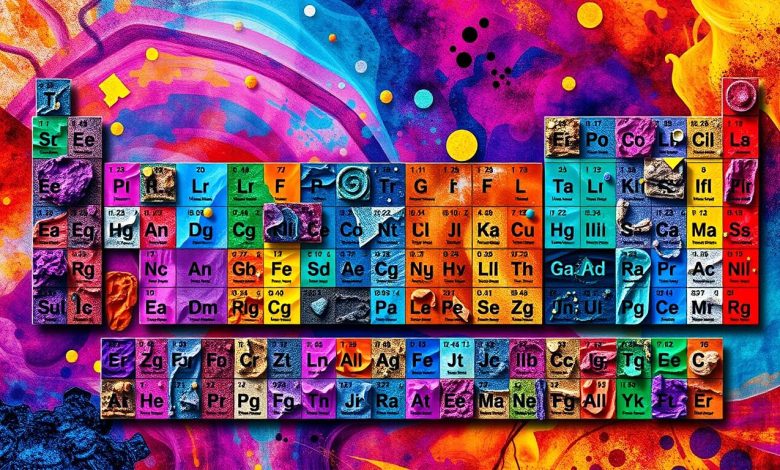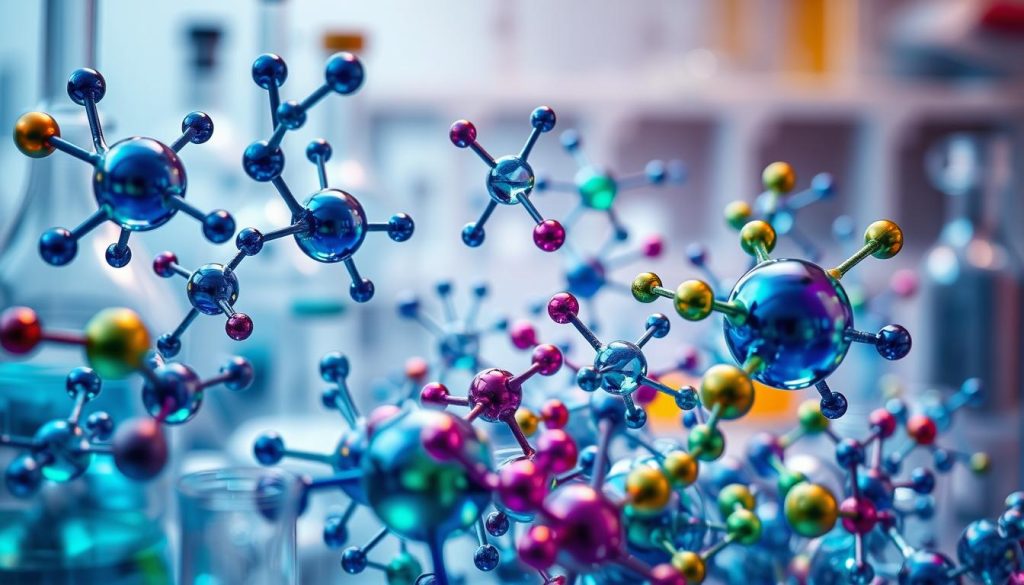Inorganic Chemistry: Differences and Applications

Inorganic chemistry is a field that studies many materials, from simple salts to complex compounds. It’s different from organic chemistry, which focuses on carbon-hydrogen compounds. Inorganic chemistry looks at compounds without carbon-hydrogen bonds. It’s key in many sciences and technologies.
One big difference is in chemical bonding. Inorganic compounds have ionic, covalent, and metallic bonds. This makes them special and useful. The periodic table helps us understand these compounds better.
Inorganic chemistry is about more than just compounds. It also explores chemical reactions and how to make new materials. Tools like spectroscopy help us study these compounds.
Inorganic chemistry has many uses. It helps make new materials and improve energy storage. It’s also important in medicine and understanding the Earth. These uses show how important inorganic chemistry is.
Exploring inorganic chemistry opens up a world of discovery. It’s a field full of unique properties and applications. It’s a fascinating area that keeps advancing our knowledge and technology.
Introduction to Inorganic Chemistry
Inorganic chemistry studies the properties and behavior of compounds without carbon-hydrogen bonds. It covers a wide range of materials, from simple ionic compounds to complex coordination complexes. This field is key for understanding and changing matter, which is vital for scientific and technological progress.
Definition and Scope of Inorganic Chemistry
Inorganic chemistry is about studying substances like metals, minerals, and compounds without carbon-hydrogen bonds. It includes topics like atomic structure, chemical bonding, and the synthesis of new materials. This field is very broad and covers many areas of study.
Historical Development of Inorganic Chemistry
Inorganic chemistry has a long history, starting in the early days of chemistry. The 18th and 19th centuries saw major breakthroughs, like the periodic table and theories on chemical bonding. The 20th century saw even more growth, with new analytical techniques and the discovery of novel materials.
Fundamental Principles of Inorganic Chemistry
Atomic Structure and the Periodic Table
Inorganic chemistry starts with understanding atomic structure and the periodic table. The table organizes elements by atomic number and electronic configuration. This helps predict trends in chemical properties like electronegativity, ionization energy, and atomic radius.
The periodic table groups elements by their atomic structure. This lets chemists guess the properties and trends of elements and their electronic configuration. Knowing this is key for making new inorganic materials with specific traits.
Chemical Bonding in Inorganic Compounds
How inorganic compounds form and stay stable depends on chemical bonding types like ionic, covalent, and coordination bonding. Grasping bonding principles, like electronegativity, oxidation states, and coordination number, is vital. It helps predict the structures and properties of inorganic compounds.
Intermolecular forces, like hydrogen bonding and van der Waals interactions, also affect inorganic materials’ behavior. These basic principles of inorganic chemistry are essential. They form a strong base for creating, synthesizing, and understanding inorganic compounds and materials.

Types of Inorganic Compounds
Inorganic compounds can be grouped into several types. These are based on their chemical makeup and how they bond. The main categories include:
- Ionic compounds, which form when cations and anions attract each other.
- Covalent compounds, where atoms share electron pairs to stick together.
- Coordination compounds, with a metal atom or ion at the center, surrounded by ligands.
- Organometallic compounds, featuring a direct bond between carbon and a metal.
Each type of inorganic compound has its own set of properties. They play key roles in fields like materials science, catalysis, and medicine. Knowing about these compounds helps us understand the world better and solve complex problems.

Ionic compounds like sodium chloride (table salt) are used a lot in food. Covalent compounds like carbon dioxide are key in studying environmental chemistry. Coordination compounds are used a lot in catalysis. And organometallic compounds are important in making new materials.
By studying inorganic compounds, scientists can make new technologies. They also learn more about the natural world’s basic rules.
Ionic Compounds and Their Properties
Formation and Structure of Ionic Compounds
Ionic compounds form when positive and negative ions attract each other. This happens because atoms want to be stable by sharing or losing electrons. The strong bonds between these ions create a crystal lattice, where ions are arranged in a repeating pattern.
The stability of ionic compounds depends on the ions’ charge and size. The lattice energy, which shows how strong the bonds are, also matters. The size of the ions affects how tightly they pack together in the crystal structure.
Applications of Ionic Compounds
Ionic compounds are used in many ways. Ceramics, like porcelain, are made from them and used in buildings, electronics, and homes. Glasses, another type of ionic compound, are used in windows, containers, and for optics.
They are also key in making fertilizers for farming and in creating pharmaceuticals. In drugs, they help with stability and solubility.
| Ionic Compound | Application |
|---|---|
| Sodium Chloride (NaCl) |
|
| Calcium Carbonate (CaCO3) |
|
| Aluminum Oxide (Al2O3) |
|
Ionic compounds have unique properties like high melting points and electrical conductivity. These properties make them essential in many areas, from daily items to advanced scientific processes.
 Law of Conservation of Mass: Why Does It Matter?
Law of Conservation of Mass: Why Does It Matter?

Covalent Compounds and Their Properties
Covalent bonding is key in inorganic chemistry. Atoms share electron pairs to form strong bonds. The structure and properties of these compounds depend on several factors.
One important aspect is the molecule’s polarity. Molecules can be either polar or nonpolar. Polar molecules have an uneven electron distribution, leading to partial charges. Nonpolar molecules have even electron distribution, resulting in uniform charges.
The polarity of a compound affects its physical and chemical properties. For example, polar compounds have higher melting and boiling points. They also dissolve better in polar solvents and have stronger intermolecular forces, like hydrogen bonding.

Covalent compounds are not just for organic chemistry. They are also crucial in inorganic chemistry. They have many uses in materials science, biochemistry, and more. Knowing about these compounds helps in creating new materials, catalysts, and medicines.
| Property | Polar Covalent Compounds | Nonpolar Covalent Compounds |
|---|---|---|
| Melting and Boiling Points | Higher | Lower |
| Solubility in Polar Solvents | Better | Poorer |
| Intermolecular Forces | Stronger (e.g., hydrogen bonding) | Weaker (e.g., London dispersion forces) |
| Reactivity | Generally more reactive | Generally less reactive |
Inorganic Chemistry in Materials Science
Inorganic chemistry is key in materials science, especially with ceramics. Ceramics are solids made of metal, metalloid, and/or non-metal elements. They are strong, hard, and stable, making them useful for many things.
Ceramics and Their Applications
Ceramic materials are used in many ways. They are in buildings, electronics, and even in our bodies. Inorganic chemistry helps us understand and improve these materials for materials science.
Semiconductors and Their Role in Electronics
Inorganic chemistry is also vital for semiconductor materials. These materials, like silicon, are used in electronics. They are changed through doping to work better in devices.
This knowledge has led to big advances in electronics. Now, we have smartphones, computers, and more. This shows how important inorganic chemistry is.

Inorganic Chemistry and Catalysis
Inorganic chemistry is key in catalysis, the study of speeding up chemical reactions with catalysts. Catalysts, whether inorganic, organic, or both, help reactions by lowering the energy needed. This makes reactions happen faster. Knowing how catalysis works, including reaction kinetics, is essential in inorganic chemistry.
Principles of Catalysis
Catalysts speed up reactions by offering a path with less energy needed. They do this through different ways, like making intermediate complexes or stabilizing transition states. Understanding these principles helps us design better catalysts for various uses.
Inorganic Catalysts and Their Applications
Inorganic chemistry has given us many catalysts for industry and technology. Homogeneous inorganic catalysts, like organometallic complexes, help make fine chemicals and medicines. Heterogeneous inorganic catalysts, like metal oxides and zeolites, are used in big processes, like making fuels and cleaning the environment. Their unique properties make them crucial in today’s chemistry and industry.
Inorganic catalysts are vital in solving big global problems. They help in environmental catalysis and energy catalysis. Their role in speeding up reactions and improving efficiency is key in sustainable energy and reducing pollution.

Analytical Techniques in Inorganic Chemistry
Inorganic chemistry uses many analytical techniques to study inorganic compounds. These methods help identify what’s in the compounds, their structure, and how they work. This knowledge helps scientists create new substances, understand how reactions work, and track changes in chemical reactions.
Spectroscopic Techniques
Spectroscopic methods like nuclear magnetic resonance (NMR) spectroscopy, X-ray diffraction (XRD), and mass spectrometry are key tools. They give deep insights into inorganic compounds. This lets researchers understand the compounds’ structure and how they work.
Chromatographic Techniques
Chromatographic techniques also play a big role in inorganic chemistry. They help separate, identify, and measure the parts of complex mixtures. Methods like ion exchange chromatography, size exclusion chromatography, and inductively coupled plasma mass spectrometry (ICP-MS) are great for studying inorganic ions, complexes, and nanomaterials. These tools help scientists understand what’s in substances, how pure they are, and how they behave. This knowledge is vital for many fields, from environmental monitoring to materials science.

| Analytical Technique | Application in Inorganic Chemistry |
|---|---|
| Nuclear Magnetic Resonance (NMR) Spectroscopy | Identification of chemical structure and composition of inorganic compounds |
| X-Ray Diffraction (XRD) | Determination of crystal structure and phase composition of inorganic materials |
| Mass Spectrometry | Analysis of elemental composition and molecular structure of inorganic species |
| Ion Exchange Chromatography | Separation and purification of inorganic ions and complexes |
| Size Exclusion Chromatography | Characterization of molecular weight and size distribution of inorganic polymers and nanoparticles |
| Inductively Coupled Plasma Mass Spectrometry (ICP-MS) | Trace-level detection and quantification of inorganic elements in complex matrices |
Inorganic Chemistry and the Environment
Inorganic chemistry is key in tackling environmental issues. Compounds like heavy metals and oxides harm our environment when released. They can pollute air, water, and soil, affecting human health.
Inorganic chemists study these pollutants. They find out where they come from and how they affect us. They also work on cleaning up and finding green chemistry solutions.
Green Chemistry Principles in Inorganic Chemistry
Inorganic chemistry leads the green chemistry movement. It aims for more sustainable chemical processes. Chemists use renewable materials and design safer chemicals.
They also focus on reducing waste. This includes making better catalysts and exploring renewable energy. Their work helps make our future greener.
 Analytical Chemistry: Methods and Techniques for Chemical Analysis
Analytical Chemistry: Methods and Techniques for Chemical Analysis
| Metric | Value |
|---|---|
| Synthesis of carbon microspheres | 22 mmol of D-glucose added to 25 mL of deionized water, maintained at 160 °C for 24 hours |
| Coating of carbon microspheres | 0.02 mol of Mg(NO3)2 ·6H2O and 0.01 mol of Al(NO3)3 ·9H2O in 150 mL of deionized water (Mg/Al = 2) |
| X-ray fluorescence (XRF) spectroscopy | Performed to determine the metal ratio in the materials |
| Elemental analysis | Conducted using an EA3000 EuroVector Elemental Analyzer to determine the carbon content |
| X-ray diffraction (XRD) | Used to assess the crystallinity of the materials |
| Fourier transform infrared (FTIR) analyses | Conducted to identify the interlayer anion in the materials |
| Scanning electron microscopy (SEM) and high-resolution transmission electron microscopy (TEM) | Used to analyze the morphology of the materials |
| Baeyer–Villiger oxidation reaction | Involved a reaction mixture including 0.012 mol of cyclohexanone, 0.098 mol of benzonitrile, 0.1 mol of 30% hydrogen peroxide solution, and 0.12 g of catalyst at 90 °C with stirring at 700 rpm |

Inorganic chemistry
Inorganic chemistry is a wide field that studies inorganic compounds. It looks at their properties, structures, and how they react. This field is key in many areas, like materials science and energy storage.
Inorganic chemistry focuses on compounds without carbon-hydrogen bonds, except for a few exceptions. This makes it different from organic chemistry, which deals with carbon-based compounds. Yet, the two fields often work together, as many important materials and processes involve both organic and inorganic parts.
Inorganic chemistry helps create advanced materials. Chemists make and study materials like ceramics and semiconductors. These materials are used in many fields, from electronics to healthcare.
This field is also vital for solving environmental problems. It works on reducing the harm caused by pollutants. Inorganic chemists use green chemistry to find sustainable solutions.
In biomedical research, inorganic chemistry has made big strides. It has led to new medical treatments and diagnostic tools. Chemists work with biologists and doctors to create these innovations.
Inorganic chemists keep improving our world with their work. Their field is essential for scientific and technological progress. It shows how important inorganic chemistry is for our future.
| Key Concepts in Inorganic Chemistry | Applications of Inorganic Chemistry |
|---|---|
|
|

Inorganic Chemistry in Geochemistry
Inorganic chemistry is closely tied to geochemistry. It studies the Earth and other planets’ chemical makeup. Inorganic chemists help us understand the Earth’s structure and how minerals form and change. They also study how elements move in the Earth’s crust and mantle.
This knowledge is key for finding and getting mineral resources. It helps us understand geological processes and how the Earth and other planets evolved.
Study of Earth’s Composition and Processes
Geochemistry uses chemistry to study geology. It looks at the elements in the solar system, Earth’s core, mantle, crust, water, and air. Inorganic chemists are crucial in figuring out how the Earth’s materials move and change.
They study how the Earth’s materials are recycled. This includes how oceanic plates sink and mountains form. This recycling is a big part of geochemical research.
Applications in Mineral Exploration and Resource Management
Inorganic chemistry is vital for finding and managing mineral resources. By analyzing rock and soil, chemists can spot valuable mineral deposits. They use X-ray diffraction, mass spectrometry, and spectroscopic methods to do this.
This work helps us find and use Earth’s mineral resources wisely. It’s important for sustainable mining and resource management.

Inorganic chemistry plays a big role in many areas of geochemistry. It helps us study meteorites and the metals in rocks and soils. It also affects human and animal health.
Organic geochemistry looks at organic materials in rocks. Biogeochemistry studies how elements move between living and nonliving things.
Inorganic Chemistry in Medicine
Inorganic chemistry has greatly helped medicine, especially in medical imaging and treatments. Metal-based compounds and nanoparticles are used as contrast agents in MRI, CT, and PET scans. They make images clearer, helping doctors diagnose and track diseases more accurately.
Inorganic Compounds in Medical Imaging and Therapy
Inorganic compounds also play a big role in treating diseases. They are used in metal-based drugs and radiopharmaceuticals. These compounds target and destroy diseased cells, making them key in creating anticancer drugs and antimicrobial agents.
Metallodrugs and Their Applications
Inorganic chemistry is key in making metallodrugs, which are used to treat many diseases. These drugs include cancer treatments and antibiotics. For example, cisplatin and radiciol are well-known for their success in medicine. Chemists keep working to make these drugs better, aiming to help more patients.

Inorganic Chemistry and Nanotechnology
Inorganic chemistry is key in nanotechnology. It deals with materials at the nanoscale. Chemists have made new ways to make and study inorganic nanostructures like nanoparticles and nanotubes.
Synthesis and Properties of Inorganic Nanostructures
These nanostructures have special properties. They are different from regular materials. For example, nanoparticles are good for energy storage and medical imaging.
Quantum dots are used in electronics and bioimaging. Nanotubes are strong and good for heat management. Making these nanostructures requires careful control over their size and shape.
 Materials Science: Properties and Applications
Materials Science: Properties and Applications
Methods like sol-gel processing and vapor deposition help. Tools like electron microscopy and X-ray diffraction are used to study them.






